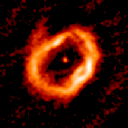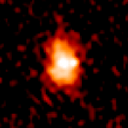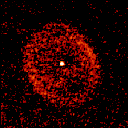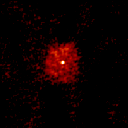



Once they have burnt all their hydrogen, heavy stars become very unstable. Eventually they may blow up, as spectacular supernovae, but first at least some of them pass through an LBV stage when they seem to be able to spontaneously eject huge amounts of mass from their outer layers in a very short time. This mass moves outwards through space away from the star at speeds of 50 to 500 kilometers per second, and after some years it can form beautiful nebulae. These nebulae can produce radio emission.
These four stars (left: AG Carinae; left middle: HR Carinae; right middle: Henize 3-519; right: WRA 751) all show nebulae. From the strength of the radio emission we can estimate how much mass was ejected by the stars during their outbursts: in these four stars it ranges from 1 to 10 times the mass of the Sun, thrown off by the star in probably less than 1 year. Some of the nebulae look like shells, as in the case of Henize 3-519, suggesting that mass was thrown out equally in all directions; but others are like HR Carinae, which is not symmetric at all.
It just so happens that most of the LBVs we know of are in the deep southern sky and not visible from the northern hemisphere. These four, plus Eta Carinae which is described in another section, are all in the constellation of Carina, where we look along one of the spiral arms which make up our Galaxy. The beautiful Carina nebula is shown in the "Miscellaneous" section of the Image Gallery.
All these image were made with the Australia Telescope , a radiotelescope near Narrabri in north-central New South Wales.